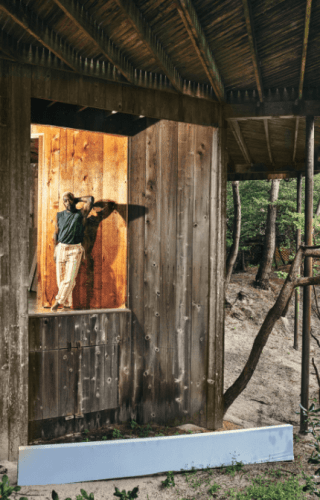
Behind This Artist’s Totemic Works Formed By The Elements
BY MONIQUE MCINTOSH
SEPTEMBER 6, 2022
Stand still long enough along Fire Island’s churning beaches, and you will witness a procession of nature’s mercurial wonders: the electric neons of sunsets, the blue-grays of pending storms, the fathoms-deep darkness of midnight. James Perkins has seen them all, distilling these moments of awe into three-dimensional paintings that undulate with currents of color and form. The artist’s slices of sea and sky, however, are not made with paint, but by exposing textiles to wind, water, heat and cold. “My goal is to infuse the material with this sensation of standing at the shoreline’s edge and feeling like the smallest thing on the planet,” he explains.
Perkins’ work evolved from his deep dive into the Light and Space art movement which emerged in California in the 1960s and heavily explored the West Coast’s landscapes through minimalism and geometric abstraction. Fire Island, where he splits the year with his wife and son, provided a natural counterpoint with its sunken pine forests, windswept coastline and radiant eastern sunrises.
Here, the artist honed his unique process into a careful waltz with the elements. Inspired by the island’s hues, he selects a colored base fabric, most often silk or linen sourced from New York’s garment district, and stretches the material onto wooden frames. He then plants these structures — some above the surface, others half submerged — around specific ecosystems, from sand dunes to his family garden. Often, Perkins will move them around multiple locations to render particular visual effects. Each placement is “based on where the sun will be and where the water will go. Even the amount of salt in the water or the wind coming off the bay versus the ocean,” he explains. “You can see where wind and water repeatedly hit immortalized on the material. I know the places where you can capture that effect.”
After months (or sometimes years), Perkins unearths his pieces and unwraps the weathered fabric, taking them to the Long Island City, Queens, studio where he works during the winter months. There, he stretches them again, this time into their final totemic shapes, carefully considering proportion, as “there is a certain scale they need to be in order to hold their own,” he notes. During this final step, the artist is mindful to leave any traces of salt and earth undisturbed.
Most of all, he hopes these works, which are available through Tappan Collective and on view at Hannah Traore Gallery in Manhattan this spring, summon for viewers their own encounters with nature in all its mystery and magnitude. Because, for Perkins, nothing feels more powerful than those moments when “you’re taking your shoes off and grounding yourself again,” he reflects. “You are hyper aware once more that you’re on earth.”